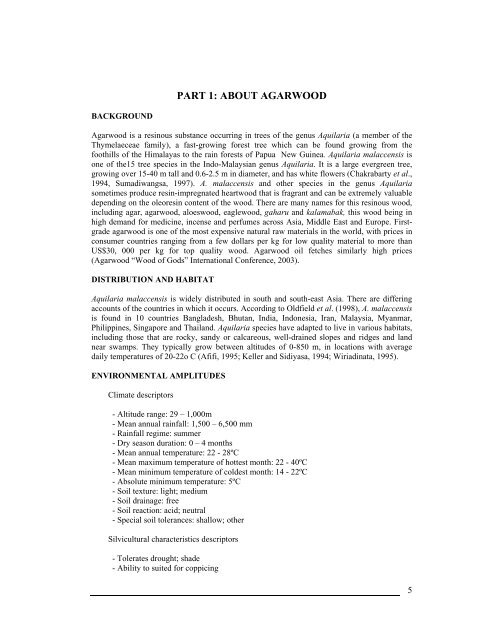PART 1: ABOUT AGARWOODBACKGROUND<strong>Agarwood</strong> is a resinous substance occurring in trees of the genus Aquilaria (a member of theThymelaeceae family), a fast-growing forest tree which can be found growing from thefoothills of the Himalayas to the rain forests of Papua New Guinea. Aquilaria malaccensis isone of the15 tree species in the Indo-Malaysian genus Aquilaria. It is a large evergreen tree,growing over 15-40 m tall <strong>and</strong> 0.6-2.5 m in diameter, <strong>and</strong> has white flowers (Chakrabarty et al.,1994, Sumadiwangsa, 1997). A. malaccensis <strong>and</strong> other species in the genus Aquilariasometimes produce resin-impregn<strong>at</strong>ed heartwood th<strong>at</strong> is fragrant <strong>and</strong> can be extremely valuabledepending on the oleoresin content of the wood. There are many names for this resinous wood,including agar, agarwood, aloeswood, eaglewood, gaharu <strong>and</strong> kalamabak, this wood being inhigh dem<strong>and</strong> for medicine, incense <strong>and</strong> perfumes across Asia, Middle East <strong>and</strong> Europe. Firstgradeagarwood is one of the most expensive n<strong>at</strong>ural raw m<strong>at</strong>erials in the world, with prices inconsumer countries ranging from a few dollars per kg for low quality m<strong>at</strong>erial to more thanUS$30, 000 per kg for top quality wood. <strong>Agarwood</strong> oil fetches similarly high prices(<strong>Agarwood</strong> “Wood of Gods” Intern<strong>at</strong>ional Conference, 2003).DISTRIBUTION AND HABITATAquilaria malaccensis is widely distributed in south <strong>and</strong> south-east Asia. There are differingaccounts of the countries in which it occurs. According to Oldfield et al. (1998), A. malaccensisis found in 10 countries Bangladesh, Bhutan, India, Indonesia, Iran, Malaysia, Myanmar,Philippines, Singapore <strong>and</strong> Thail<strong>and</strong>. Aquilaria species have adapted to live in various habit<strong>at</strong>s,including those th<strong>at</strong> are rocky, s<strong>and</strong>y or calcareous, well-drained slopes <strong>and</strong> ridges <strong>and</strong> l<strong>and</strong>near swamps. They typically grow between altitudes of 0-850 m, in loc<strong>at</strong>ions with averagedaily temper<strong>at</strong>ures of 20-22o C (Afifi, 1995; Keller <strong>and</strong> Sidiyasa, 1994; Wiriadin<strong>at</strong>a, 1995).ENVIRONMENTAL AMPLITUDESClim<strong>at</strong>e descriptors- Altitude range: 29 – 1,000m- Mean annual rainfall: 1,500 – 6,500 mm- Rainfall regime: summer- Dry season dur<strong>at</strong>ion: 0 – 4 months- Mean annual temper<strong>at</strong>ure: 22 - 28ºC- Mean maximum temper<strong>at</strong>ure of hottest month: 22 - 40ºC- Mean minimum temper<strong>at</strong>ure of coldest month: 14 - 22ºC- Absolute minimum temper<strong>at</strong>ure: 5ºC- Soil texture: light; medium- Soil drainage: free- Soil reaction: acid; neutral- Special soil tolerances: shallow; otherSilvicultural characteristics descriptors- Toler<strong>at</strong>es drought; shade- Ability to suited for coppicing5
Silvicultural practice descriptors- Seed storage recalcitrant- St<strong>and</strong> establishment using n<strong>at</strong>ural regener<strong>at</strong>ion; planting stockPests recordedPhialophora parasiticaPRODUCTION OF AGARWOODThree hypotheses exist regarding agarwood form<strong>at</strong>ion, namely th<strong>at</strong> it is the result ofp<strong>at</strong>hological, wounding/p<strong>at</strong>hological <strong>and</strong>/or non-p<strong>at</strong>hological processes (Ng et al., 1997).According to Ng et al. (1997), studies have not provided conclusive evidence for any of thesehypotheses. Oldfield et al. (1998) st<strong>at</strong>es th<strong>at</strong> resin production is in response to fungal infection,<strong>and</strong> Heuveling van Beek (TRP, in litt. to TRAFFIC Intern<strong>at</strong>ional, 2 May 2000) said th<strong>at</strong> it is inresponse to wounding. The author also adds th<strong>at</strong> fungal infection can increase resin productionas a host response to increased damage due to fungal growth. Aquilaria trees are n<strong>at</strong>urallyinfected by a variety of fungi including: Aspergillus spp., Botryodyplodia spp., Diplodia spp.,Fusarium bulbiferum, F. l<strong>at</strong>erium, F. oxysporum, F. solani, Penicillium spp., <strong>and</strong> Pythium spp.(Anon., 1998a; Santoso, 1996, cited in Soehartono <strong>and</strong> Mardiastuti, 1997; Wiriadin<strong>at</strong>a, 1995).However, the ecological interaction between the host tree <strong>and</strong> the wound <strong>and</strong>/or the fungi inorder to produce agarwood is poorly understood. Other factors such as the age of the tree,differences in the tree caused by seasonal vari<strong>at</strong>ion, environmental vari<strong>at</strong>ion <strong>and</strong> geneticvari<strong>at</strong>ion of Aquilaria spp. may also play an important role in agarwood form<strong>at</strong>ion (Ng et al.,1997). Not all Aquilaria trees produce agarwood; Gibson (1977, cited in Ng et al., 1997)estim<strong>at</strong>ed th<strong>at</strong> only approxim<strong>at</strong>ely 10% of wild Aquilaria spp. produces resin. Gianno (1986,cited in La Frankie, 1994) suggested th<strong>at</strong> only one-tenth of m<strong>at</strong>ure trees above 20 cm diameter<strong>at</strong> breast height (dbh) produce agarwood. According to Chakrabarty et al. (1994), infected treesproduce resin from the age of 20 years onwards; Sadgopal (1960, cited in Soehartono <strong>and</strong>Mardiastuti, 1997) suggesting th<strong>at</strong> the best yields are obtained from trees aged 50 years <strong>and</strong>over. Recent studies undertaken by The Rainforest Project (TRP) in Vietnam have shown th<strong>at</strong>agarwood form<strong>at</strong>ion can occur in cultiv<strong>at</strong>ed trees as young as three years of age, as confirmedby chemical analysis (H. Heuveling van Beek, TRP, in litt. to TRAFFIC Intern<strong>at</strong>ional, 2 May2000). The yield <strong>and</strong> qualities of the resinous agarwood also varies considerably (Hartadi,1997; Ng et al., 1997; Oetomo, 1995; Wiriadin<strong>at</strong>a, 1995). <strong>Research</strong> conducted in WestKalimantan, Indonesia, shows th<strong>at</strong> the yield of Aquilaria resin does not correspond with treediameter or timber volume, even when trees have similar indic<strong>at</strong>ions of infection (Soehartono<strong>and</strong> Mardiastuti, 1997). Gianno (1986, cited in La Frankie, 1994) suggested th<strong>at</strong> those treesabove 20 cm dbh th<strong>at</strong> produced agarwood provided approxim<strong>at</strong>ely one kg of agarwood per tree.However, a recent discovery from the University of Minnesota has revolutionized theagarwood production. Through a method of inocul<strong>at</strong>ion of specific chemicals, the r<strong>at</strong>e ofagarwood form<strong>at</strong>ion is increased. The p<strong>at</strong>ent right document prepared claims th<strong>at</strong> agar wouldproduction through the use of this inocul<strong>at</strong>ion increases to 30 percent as opposed to the 7percent th<strong>at</strong> occurs n<strong>at</strong>urally <strong>and</strong> more importantly this inocul<strong>at</strong>ion can be done <strong>at</strong> an youngerage than th<strong>at</strong> mentioned above.HARVESTING<strong>Agarwood</strong> is extracted from trees by felling <strong>and</strong> splitting them to reveal the resinous product.The roots of Aquilaria trees may also contain resin <strong>and</strong> if so are also harvested for trade. Asnoted above, only a rel<strong>at</strong>ively small percentage of Aquilaria trees are likely to produceagarwood. Dying trees are thought especially likely to contain agarwood, indic<strong>at</strong>ions th<strong>at</strong> trees6















![[re-tender] RFQ for supply of Diesel Generator - Brac](https://img.yumpu.com/44421374/1/186x260/re-tender-rfq-for-supply-of-diesel-generator-brac.jpg?quality=85)
